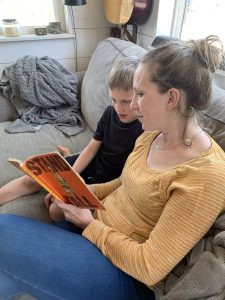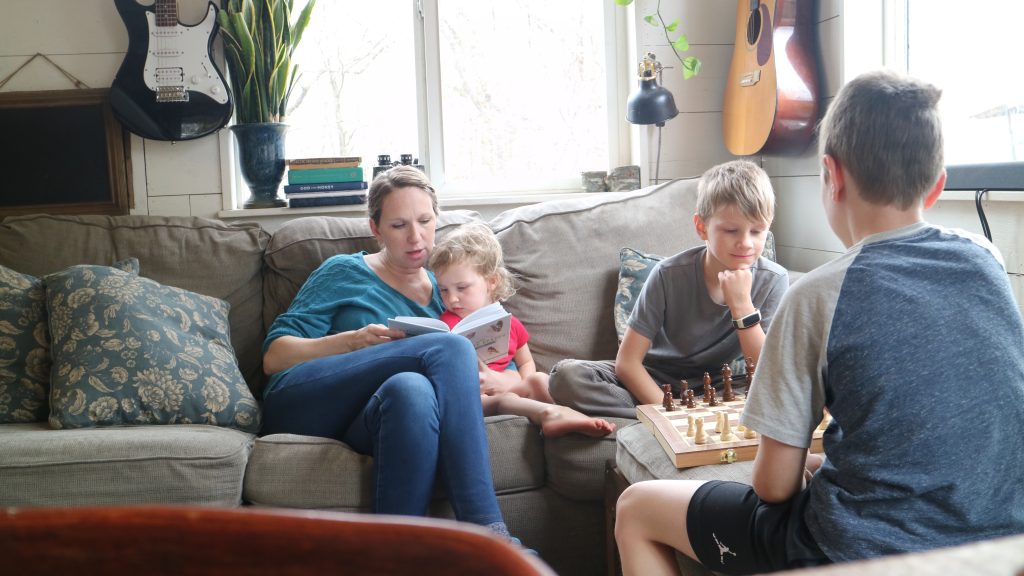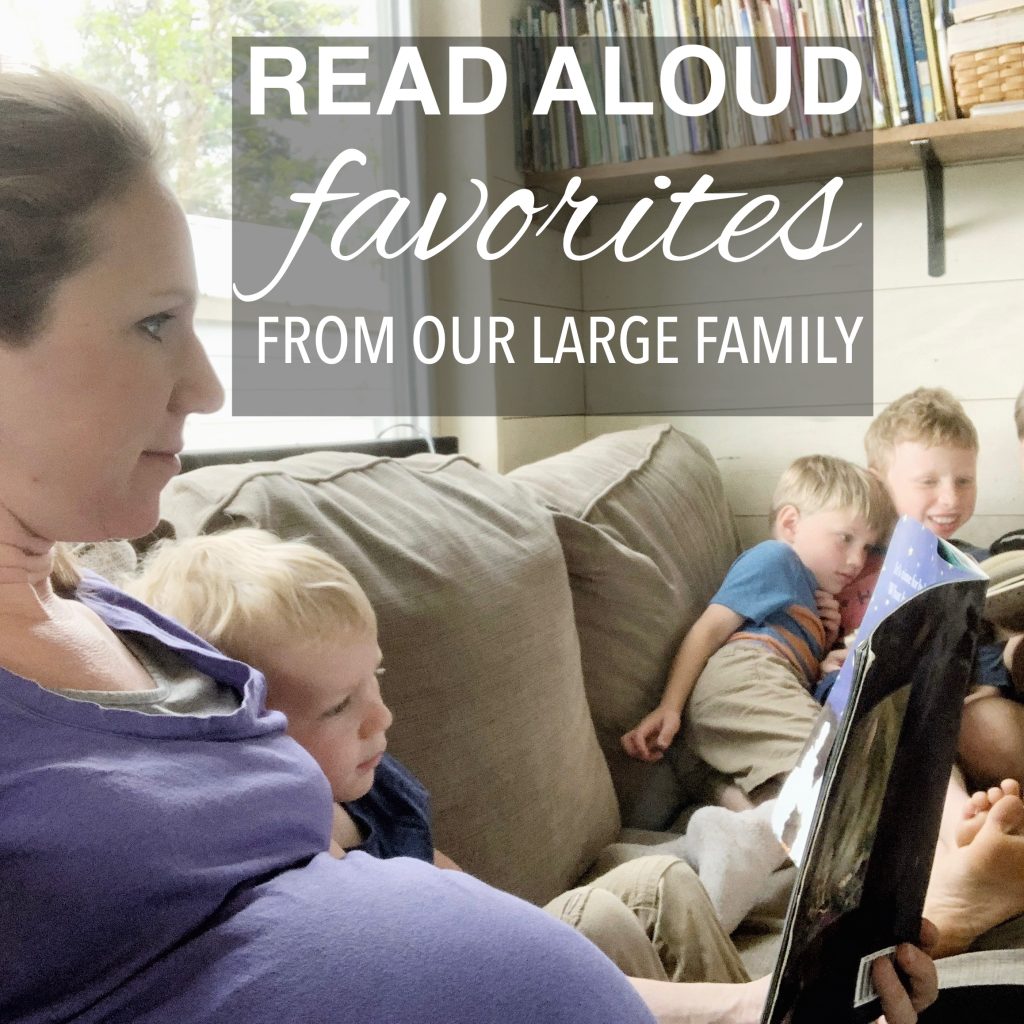You’ve completed a reading curriculum with your child but they’re still not comfortably reading on their own. Now what? There is something that you can do to help your child make the transition from a beginning reader to a fluent one. Surprisingly, it only takes a few minutes to do each day.

Struggling Doesn’t Mean Failure
I’m in the middle of teaching my seventh child to read. Five year old James is moving slow and steady through the Teach Your Child to Read in 100 Easy Lessons book. These days I am comfortable with the process, knowing that as with any new learned skill, there will be both struggles that feel impossible to push through, and leaps of understanding that are exciting and encouraging.
Learning to speak is a natural part of a child’s growth. We are wired to mimic the sounds we hear, trying again and again until we can repeat back the words we have heard since birth. Learning to read is a different process. It is a cultural invention that was developed to help us communicate, but it doesn’t come naturally in the way that speaking does.
Although I began teaching each of my seven readers in the same way, I saw vastly different results. Some of my children quickly picked up the skill as young as four years old and then jumped into reading books. Others struggled for several years before they were able to read confidently.
Both of these results can lead to success.

Move at the Child’s Pace
Every human being is born with a unique brain and we all have different strengths and weaknesses. The beauty of homeschooling is that you can move forward at the pace that is most appropriate for your child. Whether they learn to read at four years old or just before they turn the corner of nine will not matter as long as the end result is a reader.
If your child is not challenged with a specific learning disability it could be that they simply need more time and practice to perfect the skill of reading.
After The Reading Curriculum
After finishing a reading curriculum with your child you can feel a little lost. The step by step “just do the next lesson” help is gone but your child obviously needs more help to keep moving forward in their journey of becoming a reader. This is the time when you want to continue with daily one on one reading practice until your child is a fluent reader.
My first step is to pull out my stash of books for beginning readers. Over the years I have assembled a collection of books that are enjoyable to read without being too difficult. Even before the reading curriculum is completed and I’m ready to begin helping them through these beginner books, my young reader already knows the stories well because I have read them aloud many times in the past. This is a strategy I use to boost confidence. When a child is already familiar with a book that they are asked to read aloud, it helps them to feel less overwhelmed by the request.

If you haven’t read any beginner books aloud to your child yet, it’s not too late. This list includes some of our favorite books for beginners. Choose a few to start with and causally begin reading the books out loud at bedtime or other times throughout the day until your child has heard them several times. There is no need to mention that you are reading to them with the intention of having them read the books themselves. Let the process be naturally integrated in your child’s life.
Fifteen Minutes A Day
Just as you sat down with your child to work through the initial process of learning to read, continue spending daily time with them practicing reading. Do whatever you can to make this an enjoyable time in the day. I like to sit on the couch or other cozy spot with my child snuggled up to me. I keep this practice time to just 15 minutes or less per day so it remains fresh and fun. Some of my children like to use sticker charts in the beginning months to show their progress and how many days we read together.
At this point I watched my children go one of two ways. Some were reading easily and confidently within a short period of time. Others laboriously struggled through the stack of beginner reader books, progressing very slowly as the weeks went by and our daily practice continued.

Read Alongside Your Child
In those early years of trying help my first child move past the stage of painfully sounding out words into reading more fluidly, I came across a method that has worked well for my beginning readers.
We read a book together.
I choose several very simple chapter books that are an appropriate level and look like something my child would enjoy. At first I look for books that have might have some pictures and slightly larger text so there are not too many words on the page, yet have the feel of a chapter books. Over time I choose books that are harder but still achievable so my child doesn’t mentally shut down when they attempt to read them.
I then present the books to my child and let them make the choice of which one they would like to read to me. The goal of this method is to encourage a love for reading in the child, so choosing a book they enjoy is important.
Once we’ve chosen a book I explain that we are going to read this book together. They read a page, then mom reads a page (or two). Alternating readers helps the book to move along more quickly and allows the child to be drawn into the story more easily as they have a chance to just listen without having to work to understand the story while reading.
Help Them Read
When my child comes to a word they don’t know and can’t easily sound out I will causally tell them what it is. This is not the time to be laboriously sounding out words that are difficult to read. Remember, the goal of this time is to encourage love for reading. We want the story to flow along quickly so that the overall feeling of our reading time together is one of enjoyment and excitement.
I have found that as this daily practice continues over time, my children begin remembering the words that weren’t able to sound out. As their confidence increases I encourage them to sound out more words rather than just telling them. The reading journey is one that is slow but steady. One baby step at a time towards being a proficient reader.

Throughout your child’s education, listening to books read aloud continues to be an important part of their brain’s growth. Here are a few of our favorite read aloud books!

I didn’t even realize you had a homeschool blog until I watched one of your older YouTube videos! Can you make more homeschool videos in the future? I love watching your family, and am trying to figure out homeschooling for the first time this year to my four kids. Thanks for all you do. You’re such a great mom.
Well hi! I’m glad you found me here! Homeschooling is an ever evolving journey. I’m a decade in and still feel like I’m “figuring things out”. 🙂 Your children will continue to grow and change, and that means you will keep on growing and changing along with them. It is a beautiful work in progress. Keep at it mama!